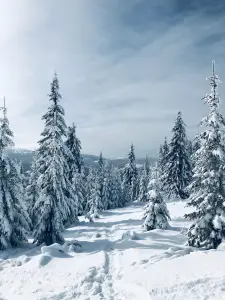When your weekends consist of lounging in front of the fireplace, cozying up with a warm blanket, and watching holiday movies on marathon; don’t forget about the icon of the holiday season- trees. Winterization of trees should start now! It is essential to give trees attention, love, and care as they battle against winter weather.
To remain in top health, winterization of trees is essential. Trees require care before and during the harsh wintery weather that keeps us drawn to the indoors. Homeowners can take measures now to make sure their trees will not only survive, but thrive, through the oncoming harsh conditions winter will bring.
PRUNE
With the return of pumpkin spice flavored everything and the colors of fall foliage beautify the environment that surrounds you, pruning season is in full effect. November is the ideal time to prune an oak tree and it is so important to offer your tall beloved trees the healthiest start to winter by making sure they are well kept. For more information on oak tree pruning, read our last blog here! Don’t let the most efficient weather for pruning pass you by before acting on the most effective season for pruning. To get on our schedule, contact us here!
WATER
Before you store away your hose and the ground begins to freeze over, water your trees! Water is essential to a tree’s growth and without it, a tree will die. Water acts as an insulator and plant cells that are swollen with water will be stronger against cold temperature damage. In addition, soil that is dryer is less likely to contain heat than soil that is moist. Therefore, protecting the roots of a tree as well. Focus watering in the area extending from the trunk to the extent of the longest branches.
Although watering is a key part in the winterization of trees, it is essential for regular watering during the winter season as well. Keith Wood, Colorado State University community forest program manager, recommends winter watering be done on warmer days when snow has melted off and the temperature is above 40 degrees.
WRAP
Jack Frost is no easy competition. Much like wearing a jacket to protect us from the low temperatures, a tree can be wrapped to protect it from wind burn and sunscald. Sunscald is a term used for injury caused by fluctuating winter temperatures. During the day, the sun warms up a tree’s bark and can cause cells to come out of dormancy. As the sun goes down and the moon comes up, that warmth disappears and the bark freezes along with the cells and conductive tissues dying causing the tree frost cracking. Younger trees and those with thin smooth bark are particularly prone to sunscald. The best way to prevent this is to wrap the tree before the winter wind whistles.
Evergreens are an icon in the Christmas season, bringing beauty into the homes of those who celebrate. Any evergreen that does not get used to spread holiday cheer inside a home, is now susceptible to winter burn and sunscald that may result in unsightly scarring. Even for those who don’t celebrate, evergreens are a common tree found on homeowners’ landscapes, as they are used for privacy. Show gratitude for the trees that represent the most wonderful time of the year and protect your privacy by protecting them from sunscald.
Wrapping trees is a key part in the winterization of trees. It is the best way to protect them before Jack Frost bites.
LAYER PROTECTION
Freezing and thawing has detrimental effects on soil as it causes it to expand and contract damaging the roots of a tree. To reduce soil evaporation, improve water absorption, and insulate against temperature extremes, apply mulch to the base of a tree. Or use wood chips as a substitute for mulch. In your effort to protect, be cautious of piling too much protection against the trunk of the tree as the base needs to “breathe”. In areas where the ground freezes and stays frozen through the rest of the season, wait to apply this protection layer until the ground has frozen to eliminate mice that may make home in the organic material.
Some communities even offer free wood chips during this time of year. Be sure to check what your community offers and take advantage of the resources available to you as you prepare your property for winter. To learn more about soil care for trees, click here.
WRAP-UP
Drastic winter temperatures send most people running for their heated homes and we don’t blame them! But before you head indoors for warmth, pay attention to what’s left out in the cold: your trees! With a few preventative steps you can ensure your trees health and survival throughout the winter season:
- Prune
- Water
- Wrap
- Layer protection
Winter can be detrimental to the health of our trees but with a little love and care, they’ll enter spring thriving rather than fighting for survival. Here at Cutting Edge Tree Professionals, we stress the importance of effective preparation of your trees both before and during the coming chilly season. To get on our schedule and ease your mind knowing your property is safely secured for winter, contact us here!
Have you given your trees a leg up in their battle against winter yet? Drop a comment down below if you have any other tips for winterization of trees!
SOURCES
https://extension.psu.edu/winterizing-your-fig-tree
https://csfs.colostate.edu/2016/10/26/fall-tips-prepare-trees-winter/
https://extension.umn.edu/planting-and-growing-guides/protecting-trees-and-shrubs-winter
https://www.lowes.com/n/how-to/protect-tree-bark-in-winter

